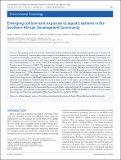Files in this item
Emerging contaminant exposure to aquatic systems in the Southern African Developmental Community
Item metadata
| dc.contributor.author | Selwe, Kgato | |
| dc.contributor.author | Thorn, Jessica | |
| dc.contributor.author | Desrousseaux, Alizee O. H. | |
| dc.contributor.author | Dessent, Caroline E. H. | |
| dc.contributor.author | Sallach, J. Brett | |
| dc.date.accessioned | 2022-02-02T12:30:16Z | |
| dc.date.available | 2022-02-02T12:30:16Z | |
| dc.date.issued | 2022-02 | |
| dc.identifier | 277693396 | |
| dc.identifier | eda4f481-bb2a-4bce-ad25-d98ee11969dc | |
| dc.identifier | 85123630576 | |
| dc.identifier.citation | Selwe , K , Thorn , J , Desrousseaux , A O H , Dessent , C E H & Sallach , J B 2022 , ' Emerging contaminant exposure to aquatic systems in the Southern African Developmental Community ' , Environmental Toxicology and Chemistry , vol. 41 , no. 2 , pp. 382-395 . https://doi.org/10.1002/etc.5284 | en |
| dc.identifier.issn | 0730-7268 | |
| dc.identifier.other | ORCID: /0000-0003-2108-2554/work/117568967 | |
| dc.identifier.uri | https://hdl.handle.net/10023/24792 | |
| dc.description | The authors gratefully acknowledge the Department of Tertiary Education Funding in Botswana, for providing a student scholarship for Kgato P. Selwe. Our study was also funded in part by the United Kingdom's Research and Innovation's Global Challenges Research Fund under the Development Corridors Partnership project (ES/P011500/1) and Peri Urban Resilient Ecosystems implemented in Namibia, Kenya, and Tanzania. Jessica P.R. Thorn was supported by a Climate Research for Development Postdoctoral Fellowship (CR4D-19-21) implemented by the African Academy of Sciences in partnership with the United Kingdom's Department for International Development, Weather and Climate Information Services for Africa (WISER) programme and the African Climate Policy Centre of the United Nations Economic Commission for Africa, and an African Women in Climate Change Science Fellowship supported by the African Institute of Mathematical Sciences Next Einstein Forum and the International Development Research Centre of Canada Aid. | en |
| dc.description.abstract | The growing production and use of chemicals and the resultant increase in environmental exposure is of particular concern in developing countries where there is rapid industrialization and population growth but limited information on the occurrence of emerging contaminants. Advances in analytical techniques now allow for the monitoring of emerging contaminants at very low concentrations with the potential to cause harmful ecotoxicological effects. Therefore, we provide the first critical assessment of the current state of knowledge about chemical exposure in waters of the Southern African Developmental Community (SADC). We achieved this through a comprehensive literature review and the creation of a database of chemical monitoring data. Of the 59 articles reviewed, most (n = 36; 61.0%) were from South Africa, and the rest were from Botswana (n = 6; 10.2%), Zimbabwe (n = 6; 10.2%), Malawi (n = 3; 5.1%), Mozambique (n = 3; 5.1%), Zambia (n = 2; 3.4%), Angola (n = 1; 1.7%), Madagascar (n = 1; 1.7%), and Tanzania (n = 1; 1.7%). No publications were found from the remaining seven SADC countries. Emerging contaminants have only been studied in South Africa and Botswana. The antiretroviral drug ritonavir (64.52 µg/L) was detected at the highest average concentration, and ibuprofen (17 times) was detected most frequently. Despite being the primary water source in the region, groundwater was understudied (only 13 studies). High emerging contaminant concentrations in surface waters indicate the presence of secondary sources of pollution such as sewage leakage. We identify research gaps and propose actions to assess and reduce chemical pollution to enable the SADC to address the Sustainable Development Goals, particularly Goal 3.9, to reduce the deaths and illnesses from hazardous chemicals and contamination. | |
| dc.format.extent | 14 | |
| dc.format.extent | 978030 | |
| dc.language.iso | eng | |
| dc.relation.ispartof | Environmental Toxicology and Chemistry | en |
| dc.subject | Africa | en |
| dc.subject | Aquatic systems | en |
| dc.subject | Emerging contaminants | en |
| dc.subject | Environment | en |
| dc.subject | South African Developmental Community | en |
| dc.subject | G Geography (General) | en |
| dc.subject | DAS | en |
| dc.subject | SDG 12 - Responsible Consumption and Production | en |
| dc.subject.lcc | G1 | en |
| dc.title | Emerging contaminant exposure to aquatic systems in the Southern African Developmental Community | en |
| dc.type | Journal article | en |
| dc.contributor.institution | University of St Andrews. School of Geography & Sustainable Development | en |
| dc.identifier.doi | 10.1002/etc.5284 | |
| dc.description.status | Peer reviewed | en |
This item appears in the following Collection(s)
Items in the St Andrews Research Repository are protected by copyright, with all rights reserved, unless otherwise indicated.

